
The two-week-long siege of Inabayama Castle marked the dramatic climax of Oda Nobunaga’s campaign to assert control over Mino Province and decisively crush the Saitō clan. It was during this operation that Toyotomi Hideyoshi, then known as Kinoshita Tōkichirō, first shone brightly in competition with Nobunaga—emerging as the future heir to Japan’s unification.
Saitō Dōsan (1494–1556), the founder of the Saitō line, epitomized the gekokujo daimyo of the Sengoku era: a schemer, backstabber, and formidable warrior. By 1552, through intrigue and military might, he had seized control of Mino Province—expelling the Toki clan—and earned the notorious nickname “Serpent Daimyo of Mino.” To reinforce his influence in neighboring Owari, he married off his daughter Keichō to Oda Nobunaga. In 1555, Dōsan’s adopted son, Saitō Yoshitatsu, believing he had been passed over for succession, rebelled and defeated Dōsan at the Battle of Nagaragawa in 1556, resulting in Dōsan’s beheading.
This event gave Nobunaga a nominal justification for invading Mino: according to some accounts, Dōsan had named him heir shortly before his death. However, lacking sufficient power at the time, the Oda-Saitō conflict remained a border dispute. Yoshitatsu then succumbed to leprosy in 1561 and was succeeded by his ineffective son, Saitō Tatsuoki—whose cowardice eroded the loyalty of many retainers and allowed Nobunaga to further extend his influence.
Seizing the opportunity, Nobunaga transferred his base to Komaki Castle and, in 1561, defeated Tatsuoki’s forces at the Battle of Moribe. Although some sources hint at an earlier 1564 attempt on Inabayama Castle, official records like the Shinchō Kōki recognize the 1567 siege as the true turning point in Nobunaga’s Mino campaign.
Beginning in 1564, Hideyoshi worked diligently to secure the loyalty of Saitō vassals—either through alliance or bribes—winning over the powerful “Triumvirate of Western Mino” composed of Ujiie Naotomo, Andō Morinari, and Inaba Yoshimichi.
In 1566, acting on Hideyoshi’s suggestion, Sunomata Castle was rapidly erected mere kilometers from Inabayama, serving as a strategic staging point for the upcoming assault.
In autumn 1567, Nobunaga’s army crossed the Kiso River and set up camp about five kilometers south of Inabayama. They were soon joined by defectors from Saitō’s retinue, substantially bolstering their ranks. Skirmishes erupted with the defenders’ advance guard as the army neared the mountain fortress—constructed atop Mount Inaba, known for its sheer northern face and a winding southern path dubbed the “Trail of One Hundred Bends.” Due to insufficient trust in Tatsuoki, command of the defense fell to Takenaka Hanbei (Shigeharu).
To clear the field of operations, Hideyoshi’s vanguard burned the castle town of Inoguchi and occupied a nearby hill. While setting up siege lines, Hideyoshi gathered intelligence—interviewing locals and receiving vital guidance from his retainer Horio Yoshiharu, a native who knew a nearly forgotten northern route. Legends say he once bested a wild boar in combat as a child, impressing Nobunaga, who valued his bravery.
Nobunaga was not one for prolonged sieges: his forces harassed the defenders daily, gradually tightening their grip. Hideyoshi proposed a daring plan: under cover of darkness, a small unit would ascend the nearly impossible north slope, infiltrate the castle, and open the gates from within. Nobunaga approved, assigning Hideyoshi to lead the commando team and Kuroda Kanbei to coordinate the main southern attack.
That night, guided by Horio, Hideyoshi’s team successfully negotiated the steep northern terrain and entered the castle. Simultaneously, the southern assault commenced. Fires erupted in the magazine and powder store, creating panic among the defenders, who believed they were under attack from both sides. In the ensuing chaos, Hideyoshi’s men opened the gates—and the main army poured in.
Miraculously, Nobunaga granted rare clemency: Tatsuoki was exiled to Ise Province, later fighting against Nobunaga under the Asakura clan before dying in battle at Tonezaka in 1573. Meanwhile, Takenaka Hanbei proved his worth and accepted a position under Hideyoshi.
Nobunaga relocated his headquarters from Komaki to the newly captured castle, renaming both the fortress and the adjoining town Gifu. Over time, Gifu Castle was significantly expanded and became the political and military center of the region.
This siege also gave rise to Hideyoshi’s famous banner—the “Golden Gourd.” His troops carried hollowed gourds (suikyo) as water flasks during the assault. Once the gates were opened, they skewered the gourds onto spears signaling to Kuroda Kanbei that the breach was secure. In honor of the success, Hideyoshi later adopted a gourd-shaped umajirushi (personal standard). While popular media often depict this standard with many gourds, historical account supports only one.
See also
-
The Siege of Hara Castle

The Shimabara Rebellion of 1637–1638, which culminated in the siege of Hara Castle, was the last major uprising of the Edo period and had serious political consequences.
-
Battle of Tennoji

The confrontation between Tokugawa Ieyasu and Toyotomi Hideyori during the “Osaka Winter Campaign” ended with the signing of a peace treaty. On January 22, 1615, the day after the treaty was signed, Ieyasu pretended to disband his army. In reality, this meant that the Shimazu forces withdrew to the nearest port. On the same day, almost the entire Tokugawa army began filling in the outer moat.
-
Siege of Shuri Castle

The Ryukyu Kingdom was established in 1429 on Okinawa, the largest island of the Ryukyu (Nansei) archipelago, as a result of the military unification of three rival kingdoms. In the following years, the state's control spread to all the islands of the archipelago.
-
The Siege of Fushimi Castle
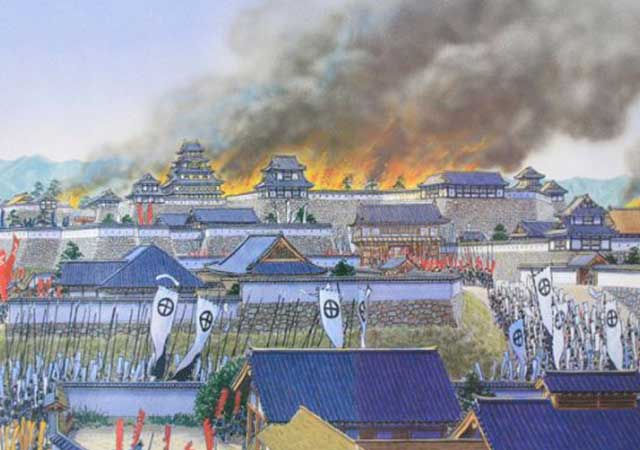
Fushimi can perhaps be considered one of the most “unfortunate” castles of the Sengoku Jidai period. The original castle was built by Toyotomi Hideyoshi in the southeast of Kyoto in 1594 as his residence in the imperial city.
-
The Siege of Otsu Castle
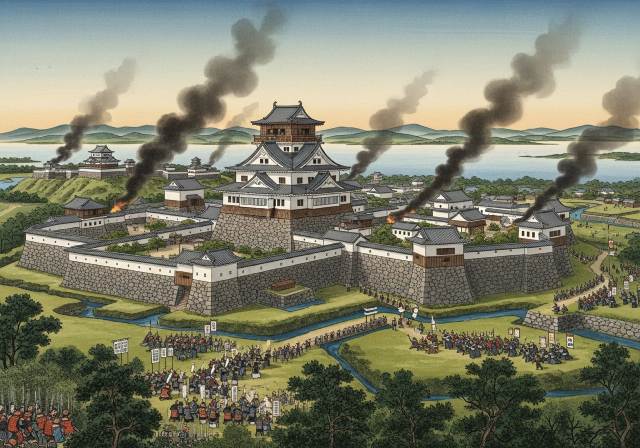
The siege of Otsu Castle was part of the Sekigahara campaign, during which the so-called Eastern Coalition, led by Tokugawa Ieyasu, fought against the Western Coalition, led by Ishida Mitsunari. Otsu Castle was built in 1586 by order of Toyotomi Hideyoshi near the capital Kyoto, on the site of the dismantled Sakamoto Castle. It belonged to the type of “water castles” — mizujō — as one side of it faced Japan's largest lake, Lake Biwa, and it was surrounded by a system of moats filled with lake water, which made the fortress resemble an island.
-
The Siege of Shiroishi Castle
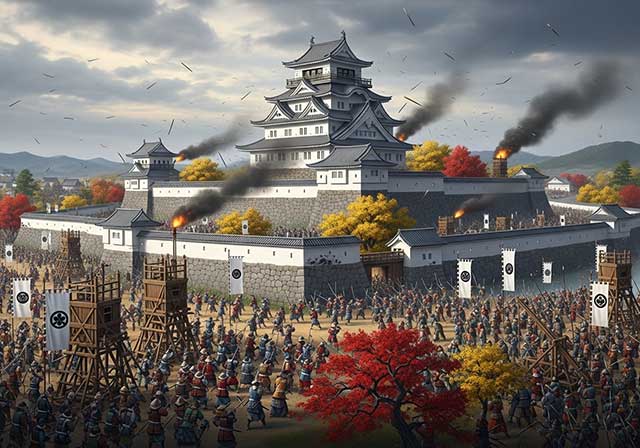
The siege of Shiroishi Castle was part of the Sekigahara campaign and took place several months before the decisive battle of Sekigahara. The daimyo of Aizu Province, Uesugi Kagekatsu, posed a serious threat to Tokugawa Ieyasu's plans to defeat the Western Coalition, and Ieyasu decided to curb his actions with the help of his northern vassals. To this end, he ordered Date Masamune to invade the province of Aizu and capture Shiroishi Castle.
-
The Second Siege of Jinju Castle
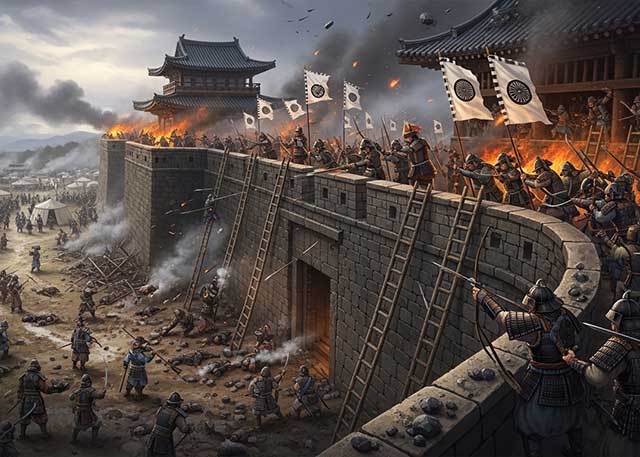
During the two Korean campaigns of the 16th century, the Japanese repeatedly had to capture enemy fortresses and defend occupied or constructed fortifications from the combined Korean and Chinese forces. Among all the operations of that time, the second siege of Jinju Castle is considered the most interesting from the point of view of siege warfare.
-
The Siege of Takamatsu Castle
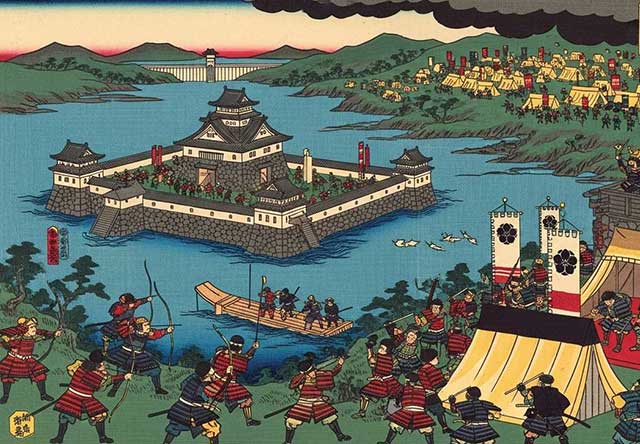
The siege of Takamatsu Castle in Bitchu Province is considered the first mizuzeme, or “water siege,” in Japanese history. Until then, such an original tactic had never been used.

